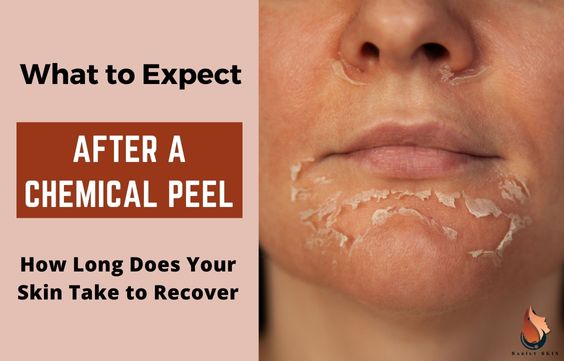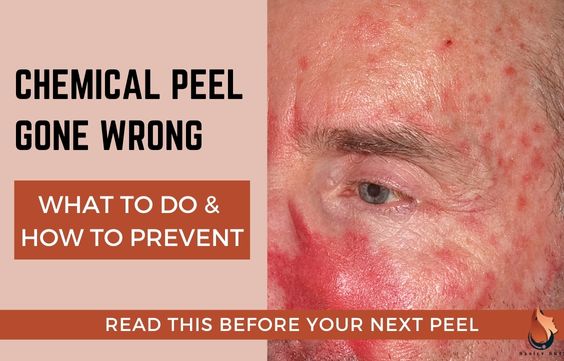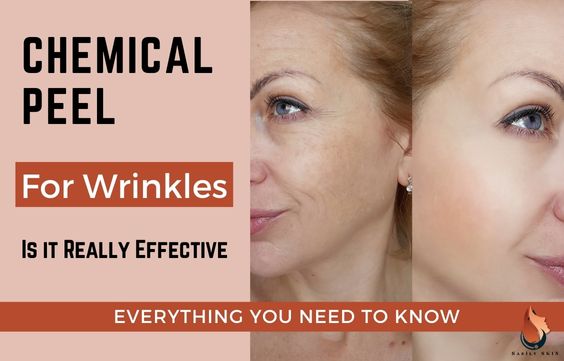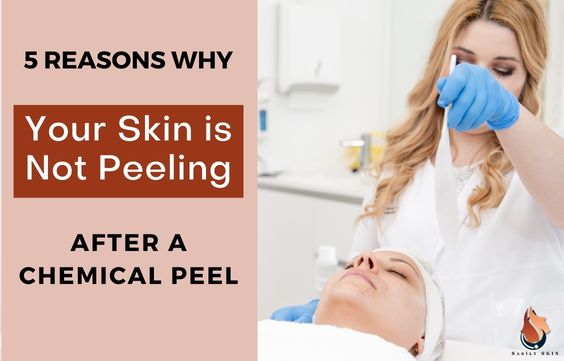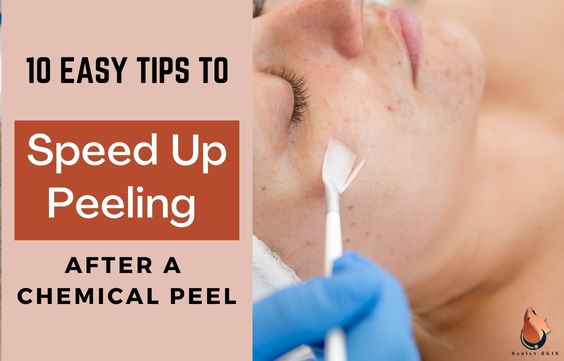Chemical Peel For Hyperpigmentation: Ultimate Guide
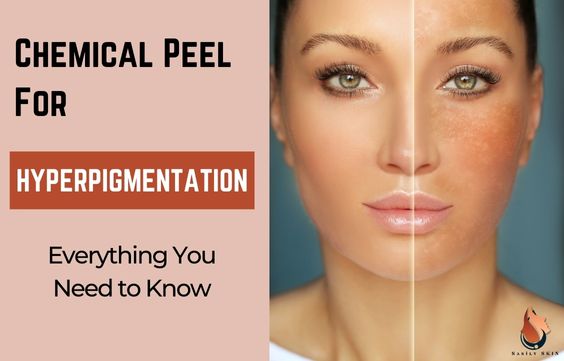
Chemical peels have become one of the gold standard procedures that are used to treat hyperpigmentation of the skin. It is safe and very effective when done correctly.
If you’re struggling with hyperpigmentation and you’re considering having a chemical peel done to treat it, you’ve come to the right place! Let’s explore the basics of hyperpigmentation and how the right chemical peel can help.
What is Hyperpigmentation
Hyperpigmentation is a common and usually harmless skin condition in which certain areas of the skin appear darker in color and tone. This can occur in uniform areas or as patches or blotches.
This darkening occurs when an excess of melanin, the brown pigment that produces normal skin color, forms increased deposits in the skin.
Hyperpigmentation can affect people of any skin tone. Citation.
How Does a Chemical Peel Treat Hyperpigmentation?
Chemical peels can significantly diminish discolored areas of skin, especially at high concentrations, by;
- Eliminating damaged cells.
- Increasing skin cell turnover, replacing them with healthy, normal cells.
- Prepares the skin to receive topical applications like azelaic acid, which can help reduce discolouration even more.
- Disrupting melanin synthesis, the pigment that gives skin its color. It accomplishes this by suppressing tyrosinase activity. Citation.
Related Article – Chemical Peels can be used to also treat Wrinkles, you can click here to learn more.
Best Chemical Peel for Hyperpigmentation
The type of chemical peel that will be best for you will depend on the type and extent of your hyperpigmentation, as well as your skin type.
The type of chemical peel that is chosen will also depend on the depth that it will penetrate and the concentration of the chemical peel solution.
However, generally, the best chemical peels to treat hyperpigmentation are:
- Glycolic acid Peels- Tend to be milder & better for sensitive skin
- Lactic Acid Peels
- Salicylic Acid Peels
- Trichloroacetic Acid (TCA) Peels (Most effective but harsher on your skin)
Related Article – Chemical Peels for Dark Inner Thighs: What You Need to Know
1- Glycolic Acid Peels (AHA Peels)
AHA peels include acids like glycolic acids, lactic acid and mandelic acid. The most common AHA acid used to treat hyperpigmentation is glycolic acid.
A glycolic acid peel is considered a light or superficial peel. This means that it only removes the top layer of the skin. It is better suited to treating surface-level hyperpigmentation and it is effective even on dry skin.
How to Use Azelaic Acid for Acne Scars & Dark Spots
Benefits of Glycolic Acid Peels For Hyperpigmentation
1- Breaks Down Excess Keratin in Your Skin
Glycolic acid has strong anti-inflammatory, keratolytic (it breaks down excess keratin in the skin), and antioxidant properties.
Glycolic acid, as a keratolytic, may soften and break down the skin’s outer layer, allowing it to deeply exfoliate and remove scaly, flaky skin. This action also increases the effectiveness of topical treatments by allowing them to penetrate the skin more easily.
Benzoyl Peroxide To Treat Acne Scars & Dark Spots
2- Cleanses Pores Preventing more Dark Spots from Forming
The tiny molecular size of glycolic acid allows for deep penetration to cleanse pores of excess oil, debris, and acne-causing bacteria,
3- Heals the Skin
Glycolic acid peels have an anti-aging benefit. They provide controlled damage to the skin to stimulate regeneration and remodeling.
As part of the healing process, elastin and collagen production increases, firming, plumping, and strengthening the skin for a more youthful appearance.
As an antioxidant, when coupled with vitamin E and melatonin, glycolic acid has been demonstrated to have a stimulatory effect. This means that glycolic acid may greatly affect the action of both chemicals, enhancing the skin’s ability to provide sun protection.
This will help if you are prone to getting sunburns.
3- Treats Acne
If you suffer from acne along with your hyperpigmentation, a glycolic acid peel may successfully treat all forms of acne.
It is particularly efficient in eliminating blackheads and whiteheads, or comedonal acne, due to its effectiveness in cleansing pores of dirt and material.
A glycolic acid peel works to treat acne by entering the pores to dissolve and remove acne-causing oil accumulation. This also aids in the reduction of the size of enlarged pores which can also help prevent and cure acne.
Who Should Get Glycolic Acid Peels
AHA peels are ideal for individuals who desire to remove dark pigmentation, treat acne, and battle the effects of aging are ideal candidates.
Glycolic acid peels are most suitable for those with oily skin types. This is because glycolic acid peels are drying, so they will cause less irritation on oily skin.
Glycolic acid peels can be used on persons who have rosacea, skin sensitivity, or dark skin tones. But they must be performed by a clinician who is competent in treating these patients as they can damage the skin and worsen hyperpigmentation if not done properly.
Precautions When Taking Glycolic Acid Peel for Hyperpigmentation
- Glycolic acid for skincare use is usually available in concentrations of 20-70%. But the strength and depth of the peel will depend on your skin’s condition and your doctor’s recommendation.
- Glycolic acid peels can make skin particularly sun-sensitive; as a result, it is critical to apply a high SPF sunscreen for at least 6 weeks after the peel.
- To prevent robbing skin of much-needed moisture, wash your face with a mild soap-free cleanser and avoid retinol and salicylic acid until your skin has fully recovered.
- Every four weeks, you can safely undergo a glycolic acid peel. To attain your objective, several treatments can be done over 4–6 months as each peel has a cumulative impact. However, the safest thing to do would be to consult your doctor.
- Glycolic acid peels should not be used in normal concentrations during pregnancy. Your doctor should be consulted and a much lower concentration will most likely be recommended if it is necessary.
- Glycolic acid peels are not regulated by the FDA and improper use can cause skin damage. It is always safe to consult a professional before using rather than attempting to do it yourself at home. Citation
2- Lactic Acid Peel
If you are looking for a milder and weaker alternative to the glycolic acid peel to treat hyperpigmentation then we recommend a lactic acid peel. It is suitable for individuals with more sensitive skin.
Lactic acid is another type of AHA acid peel, it tends to be milder than glycolic acid
3- Salicylic Acid (BHA) Peels
The most commonly used BHA peel is salicylic acid. This acid has anti-inflammatory properties which make it great for use in areas where hyperpigmentation is caused by inflammatory conditions like acne.
Salicylic Acid also works very well on oily skin.
Benefits of Salicylic Peels For Hyperpigmentation
1- Very Effective Exfoliant
Salicylic acid is desmolytic. This means that it effectively exfoliates the skin by interrupting the connection within the skin itself that hold it together.
2– Great to treat Acne
Acne can cause hyperpigmentation, and salicylic acid can be used to correctly treat acne without causing dark spots from forming.
Salicylic Acid is:
- Comedolytic. In non-med terms, this means that it gets rid of dirt, oil, and dead skin cells that can plug up pores and cause acne blemishes.
- Anti-inflammatory. This means that it prevents and reduces inflammation in the skin which effectively treats acne.
- It has anti-fungal properties which makes it helpful for the treatment of fungal acne.
- It lowers oil production. Your skin produces sebum (skin oil) naturally, but too much of it can clog pores and cause acne. Salicylic acid breaks down oil and limits its production in the skin.
Who Should Get a Salicylic Acids
Salicylic acid peels are safe and well-tolerated by all racial/ethnic groups and in all skin types (Fitzpatrick I–VI).
If you have darker skin, you should consult a doctor before using salicylic acid peels to prevent hypopigmentation (excessive loss of color from your skin). The aim is to reduce hyperpigmentation (excess pigment) but not to bleach your skin.
Precautions When Taking Salicylic Acid Peel for Hyperpigmentation
- Do not use salicylic acid peels if you are pregnant. Citation.
- Avoid using salicylic acid peels over areas of your skin where you have a rash, broken skin, sunburn, cuts, bruises, or any irritation.
- You should not use salicylic acid peels if you are also using isotretinoin (Accutane).
- Do not use salicylic acid if you have a skin malignancy.
- Salicylic acid peels are not regulated by the FDA and improper use can cause skin damage.
It is always safe to consult a professional before using rather than attempting to do it yourself at home. Citation.
4- Trichloroacetic Acid (TCA) Peels
TCA is made from acetic acid, a vinegar derivative, and is accessible in concentrations ranging from 15–to 70%. It is used to exfoliate the top layer of skin off the face, neck, hands, and other regions of the body.
TCA peels are considered to be medium to deep peels and should be administered by a professional.
How bad your hyperpigmentation is will determine how strong the concentration of the TCA peel will need to be. This is usually used for hyperpigmentation that is deposited deeper into the layers of the skin since it penetrates deeper. Citation.
Benefits of Using TCA Peels
1– Very Strong Treatment for Hyperpigmentation
TCA works by disassembling keratin, a protein present in the skin. This causes the keratin to cease working correctly, fade in color, and peel away from the skin over a few days.
As the layers of damaged skin are removed, the healthier, smoother skin beneath is revealed.
Light peels with 10–15% concentrations can heal hyperpigmentation, whereas peels with 20% concentrations can treat sun-damaged or aging skin, as well as tiny scars.
Deeper wrinkles, scars, and precancerous growths are treated with medium peels of 30–35%.
2- Heals Scars and Dark Spots Caused By Acne
TCA is an excellent post-acne scar therapy. It smoothes the skin’s texture while also reducing post-inflammatory hyperpigmentation, which is the dark coloring that appears after a blemish has healed.
The CROSS approach can effectively cure atrophic acne scars, often known as icepick or boxcar scars, with high doses of TCA (70%).
The CROSS procedure includes injecting TCA into each depression to rebuild scar tissue and smooth out the skin. This therapy is done every few weeks for several months by a trained professional.
3- Eliminates Sunspots
TCA is efficient in reducing sun damage at any concentration by eliminating sunspots (flat, brown patches caused by sun exposure) and enhancing skin tone and texture.
It is very good in increasing skin suppleness and moisture, both of which are indicators of healthy, undamaged skin.
4- Very Strong Peeling Agent
TCA is more effective than other typical peeling agents, such as salicylic acid and glycolic acid, even at low doses. As a result, it has a greater ability to resurface the skin with a single treatment.
Video Showing the Effect of a TCA Peel on Hyperpigmentation
Who Should Use TCA Peels
The best candidates for a TCA peel are people with light to medium skin tones, who have:
- Healthy skin with no history of thickened scarring or poor wound healing,
- No active infections or autoimmune skin conditions,
- Less sensitive skin.
Precautions When Taking TCA Peel for Hyperpigmentation
Even though TCA peels can work faster than lighter peels, it also carries the additional risk of causing more damage to the skin and it has a longer recovery time.
Therefore, you should be careful when deciding the depth and frequency of your TCA peel.
- People with darker skin tones are at risk for increased hyperpigmentation so they should have a TCA peel done by a trained professional or consider alternatives. Citation.
- TCA chemical peels may be tolerated by all skin types, though perhaps not always at high doses. To reduce the possibility of lasting skin darkening or other unpleasant side effects, persons with very light or dark skin should exercise caution.
- Are not recommended if you tend to create keloid scars (thick, raised scars), if you are taking medicine that makes your skin light-sensitive, or if you have any active bacterial, fungal, or viral infections.
- You should not use a TCA peel if you are pregnant or breastfeeding.
- You should not use a TCA peel if you have other skin conditions like psoriasis, eczema, or rosacea.
- You should avoid sun exposure after a TCA peel, so if your job or life requires you to be outside, a TCA peel might not be good for you.
Chemical peels for Hyperpigmentation on Dark Skin
If you have darker skin (Fitzpatrick types 4-6), using a chemical peel may increase your risk of worsening your hyperpigmentation or causing new patches, especially if it is not done correctly.
If you do decide that a chemical peel is best for you, the most suitable one is a light BHA peel like salicylic acid, which is mild and anti-inflammatory.
This means that it will lessen any hyperpigmentation that might occur after the inflammation process of the peel.
How Many Sessions are Needed for Hyperpigmentation?
Depending on the type of peel that you have gotten, and how bad your hyperpigmentation is, you may need between 1 and 5 chemical peel sessions to achieve the results that you want.
Light peels can be performed, as directed by your doctor, every 3-4 weeks.
However, medium peels should be spaced months apart, and deep peels can only be done once. This is to avoid permanently damaging your skin.
How Much Does a Chemical Peel for Hyperpigmentation Cost
Generally, light peels can cost as low as $100, and medium peels can cost up to $3,000 or more (specifically if it requires anesthesia or in-patient stays). Citation.
According to the American Society of Plastic Surgeons, the current average cost of a chemical peel is $673.
Chemical peels are generally thought of as a cosmetic treatment, and insurance seldom covers them.
You will have to pay for the treatment yourself. However, your initial consultation session may be reimbursed by insurance.
| Type of Peel | Glycolic Acid Peel | Salicylic Acid Peel | TCA Peel |
| Average Cost | $200 – $600 | $100 – $300 | $300 – $1000 |
Now the cost of the procedure will vary depending on factors like:
- Location
- The expertise of the provider
- The type of peel you want to get
- The prep that goes into your skin and the procedure
- Any after-peel medication or material needed
However, for a better average, here is a cost comparison between glycolic acid peels, salicylic acid peels, and TCA peels according to AEDIT as of 2020: Citation.
Keep in mind that sometimes, costs will also extend to after-procedure care, especially if complications develop. Therefore, the average costs listed here are not set in stone.
The cost of your entire peeling process may be less or more, depending on the specifics of your situation. Citations
Alternative Treatments for Hyperpigmentation
If your skin cannot withstand a TCA chemical peel, glycolic acid, or salicylic acid peels, then microdermabrasion, and microneedling are options for addressing minor skin concerns such as hyperpigmentation.
Laser skin resurfacing can address more serious skin damage and indications of aging.
Causes and Types of Hyperpigmentation
Hyperpigmentation can be focal (limited to one area) or diffuse (spread across the skin in various areas).
Focal hyperpigmentation usually occurs after some kind of injury to the skin. Injury can be caused by:
- Physical harm like burns, cuts, bruises, etc.
- Acne
- Lupus
- hormonal changes (which cause melasma)
- Freckling
- Excess sun exposure (which results in sunspots or liver spots)
- Insulin resistance (which results in a focal darkening of the skin and a velvety plaque called acanthosis nigricans)
Diffuse hyperpigmentation can be caused by some medical drugs, some chronic illnesses (like Addison’s Disease, for example), and some cancers. Citation.

